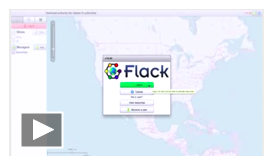
|
- Go to http://www.protogeni.net/flack and press the Log in button
- From the select authority drop down menu, select the site authority for your GENI account, most probably pgeni.gpolab.bbn.com and press the Download button
- Answer yes in the pop-up window
- Login to the new window using your GENI account
- Reload the Flack tab and repeat steps 1 and 2
- After your private key and certificate are loaded, type your GENI passphrase in the box
- Select the sites you want. For this tutorial we only need the utahemulab.cm site.
|



